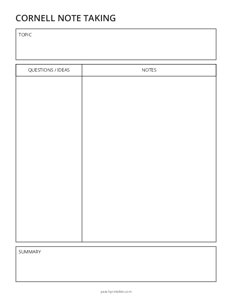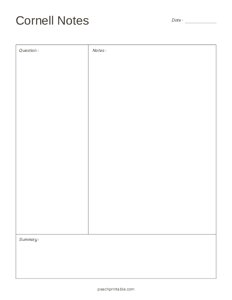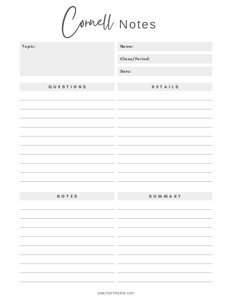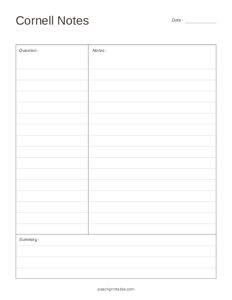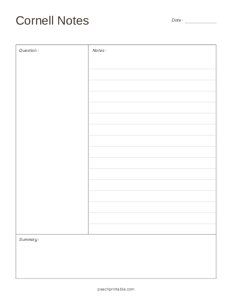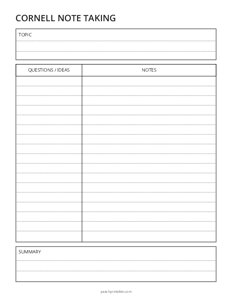Cornell Notes Templates
The Cornell Note-taking System itself is a popular method for organizing and summarizing information. The template helps you visually separate your notes into sections to improve recall and critical thinking.
It's widely used by students to organize their notes in a systematic and efficient manner. The format divides the page into three sections: Notes, Cues, and Summary.
Showing 1-6 of 6 records
Cornell Note Taking - Plain
Minimalist Cornell Notes - Plain
Cornell Notes
Minimalist Cornell Notes - Lined
Minimalist Cornell Notes - Partial Lined
Cornell Note Taking - Lined
Common Cornell Notes Template Layout
Here is the layout and uses of Cornell notes templates.
Notes Section (Right-hand Column)
- Details: This is the largest section and takes up about two-thirds of the page on the right-hand side.
- Uses: During a lecture or while reading, this section is used to jot down the main notes, including key points, diagrams, formulas, and important facts. Write down information in a way that makes sense to you, using bullet points, sentences, or shorthand.
Cues Section (Left-hand Column)
- Details: This is a narrow column on the left side of the page.
- Uses: After the lecture or reading, this section is used to write down questions, keywords, or main ideas that serve as cues for reviewing the notes. These cues help trigger the information recorded in the notes section. It also helps in self-quizzing and active recall during study sessions.
Summary Section (Bottom of the Page)
- Details: This section is located at the bottom of the page and typically takes up about one-fifth of the page.
- Uses: After the notes and cues sections are filled out, this part is used to write a brief summary of the page's notes. Summarizing helps in consolidating the information and provides a quick reference for future review.
How to Use the Cornell Notes System
- Record: During the lecture or while reading, write notes in the Notes section. Focus on main ideas, concepts, and key details.
- Questions/Keywords: After the lecture or reading, fill in the Cues section with questions or keywords that correspond to the notes. These should help you recall the material.
- Recite: Cover the Notes section and try to answer the questions or recall the information using the cues. This reinforces learning.
- Reflect: Think about the material and how it fits into what you already know. Consider any questions or connections you can make with other topics.
- Review: Regularly review your notes, the cues, and the summary to keep the information fresh in your mind. This can be done in short, frequent sessions to enhance retention.
Benefits of Cornell Notes
- Stay Organized: The structured format helps keep notes organized and makes it easier to find specific information.
- Active Learning: The process encourages active engagement with the material, which enhances understanding and retention.
- Efficient Review: The cues and summary sections facilitate quick and effective review sessions.
- Customizable: The template can be adapted to fit different subjects, types of content, and personal preferences.
Using the Cornell Notes system can significantly enhance your study habits and help you retain information more effectively.

